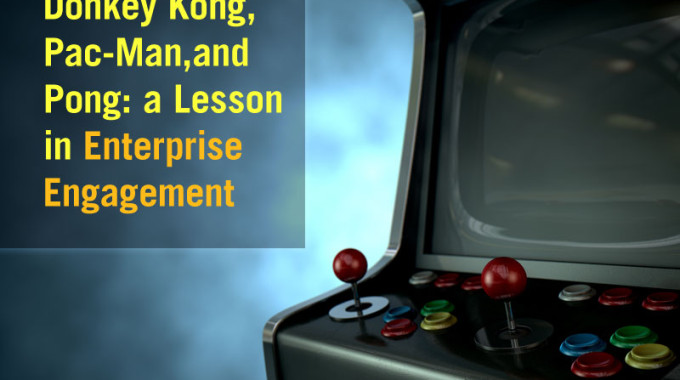As a thought leader, you may be great at telling stories through a presentation deck,…
Donkey Kong, Pac-Man, and Pong: a Lesson in Enterprise Engagement

As a child, I remember the magical Saturday afternoons when I’d take a precious handful of quarters to the arcade for an engaging challenge of skill and wits. The early video games—Pong, Pac-Man, Space Invaders, Donkey Kong—were all alluringly simple on the surface but difficult to master. Each time I missed a volley in Pong or got tagged by “Inky,” the clever blue ghost in Pac-Man, I would tell myself that I could improve, I just needed to keep playing (it’s a great business model). Each game was driven by a few simple rules. The more you learned the rules, the better you played the game.
For many years, most thought leaders were able to thrive with a very lean organization. When you’re out on the speaking circuit, you might only need a good admin to help you schedule sales calls and manage your travel logistics. In this simplified world, the enterprise engagement followed a pretty clear and consistent set of rules. You could close a speech or workshop in one or two calls.
If you wanted to sell workshops after the speech, you connected with the senior leader who had the budget and authority to make the decision. Your speaker credentials granted you a red-carpet level of access to these decision makers, and frequently those one-on-one conversations led to handshake deals.
However, like our video games, the enterprise sales process has become increasingly complex.
A study of 5,000 B2B stakeholders published in Harvard Business Review found that, “on average, 5.4 people now have to formally sign off on each purchase.” Instead of selling to one decision maker, organizational buyers are making consensus decisions.
Large organizations have become more sophisticated. They can draw upon a wealth of talent—different roles and geographies—to evaluate any opportunity. That’s especially true if you want to sell an enterprise wide initiative that will change how people think and act, one that brings measurable results to teams and business units.
In order to successfully sell an enterprise engagement around your thought leadership, you’ll be racing through an organizational maze designed to test your skill and agility:
Business unit leaders ask questions about time investment and impact;
HR asks about your content’s behaviorally-based learning objectives;
IT asks a dizzying set of technical questions around how your materials will interface with the organization’s learning management system and social media platform.
Organizational development folks ask for the technical report that discusses the statistical reliability and validity of your developmental assessment.
Procurement sends you their standard contract whose clauses range from simply unacceptable (asking you to grant them ownership of your IP) to the bewilderingly irrelevant (asking you to submit a copy of your Nuclear Waste Handling Certificate).
You’re not just playing one game. You’re playing multiple games simultaneously .
Suddenly, Donkey Kong is throwing barrels at you while you’re trying to volley Pac-Man past the assault of Space Invaders. It’s enough to make even seasoned thought leaders throw their hands up in frustration and say, “It’s too complicated. This new game is unwinnable.”
And that’s likely true for almost any single-shingle thought leader attempting to close enterprise-wide deals in today’s marketplace. When enterprises commit 5+ people to a buying decision, they’re doing their due diligence—testing both the breadth of your organizational savvy and your bandwidth. And if you make a misstep at any point, it’s “Game Over” for your proposed initiative.
Want to play? Well, you can! Click here and download it. It’s free!
From the organization’s perspective, it’s better to stress test the thought leader’s capacity early during the sales cycle, before they’ve punched in their quarters—rather than discover limitations halfway through a pilot.
Because enterprise sales and implementations are so complex, thought leaders typically need more than a single pair of hands; they need a player two, and sometimes three or four, an on-call team with expertise in many supporting fields—such as sales, sales engineering, and organizational consulting.
When you pass the challenges within the organizational buying cycle, you signal that you will likely have the skills, dexterity, resources, and bench strength necessary to move on to the next level.





